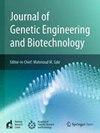NanoFlora: Unveiling the therapeutic potential of Ipomoea aquatica nanoparticles
IF 2.8
Q3 Biochemistry, Genetics and Molecular Biology
Journal of Genetic Engineering and Biotechnology
Pub Date : 2025-03-01
DOI:10.1016/j.jgeb.2025.100470
引用次数: 0
Abstract
Introduction
Improving the pharmacokinetics of drugs is achieved through nano formulations and the role of natural product in the synthesis of nanomaterials is gaining prominence due to its eco-friendly nature, cost-effectiveness, and demonstrated efficacy. Metal nanoparticles (NPs) derived from Ipomoea aquatica Forsskal have been synthesized and evaluated for their antioxidant and antidiabetic properties towards enhancing the anticancer activity of the plant extracts.
Methodology
Hydroalcoholic extract was obtained from the entire Ipomoea aquatica plant and utilized as a key ingredient in the green synthesis of metal NPs. The characterization of the synthesized NPs involved UV/visible and FT-IR spectroscopic analyses, along with particle size determination using Zetasizer technology. Antioxidant activity was assessed through DPPH radical scavenging assays, while antidiabetic potential was evaluated via alpha-amylase inhibitory activity using HPTLC bioautography.
Results
The formation of silver nanoparticles (AgNPs) was confirmed by a color change from light brown to dark brown. UV–VIS spectrum analysis showed strong absorbance between 380 and 400 nm, with a peak at 428 nm, indicating successful synthesis via bioreduction by Ipomoea aquatica extract. FT-IR spectra revealed phytochemicals like flavonoids and proteins, with shifts in peak positions confirming AgNP formation. DLS showed an average particle size of 36.27 nm, and TEM images confirmed spherical morphology. The AgNPs exhibited significant antioxidant and antidiabetic activities, outperforming standards such as ascorbic acid and Glibenclamide. Toxicity prediction identified the extract as slightly toxic, guiding safe dose administration.
Conclusion
The study underscores the potential of plant-based nanoparticles in scavenging free radicals and supporting cytotoxicity, thus hinting at their potential role in cancer therapy. Moreover, the nanoparticles derived from Ipomoea aquatica exhibit promising antioxidant and antidiabetic activities compared to the crude plant extract. This research paves the way for further exploration of Ipomoea aquatica nanoparticles as a novel therapeutic intervention for various diseases.
纳米植物:揭示水生苕纳米颗粒的治疗潜力
改善药物的药代动力学是通过纳米配方实现的,天然产物在纳米材料合成中的作用因其生态友好性、成本效益和已证明的功效而日益突出。本文合成了从水生植物Ipomoea aquatica Forsskal中提取的金属纳米颗粒(NPs),并对其抗氧化和抗糖尿病特性进行了评价,从而提高了植物提取物的抗癌活性。方法从全株水草中提取水醇提取物,并将其作为绿色合成金属NPs的关键成分。合成NPs的表征包括紫外/可见光和FT-IR光谱分析,以及使用Zetasizer技术测定粒度。通过DPPH自由基清除试验评估抗氧化活性,而采用HPTLC生物自显影法通过α -淀粉酶抑制活性评估抗糖尿病潜力。结果银纳米颗粒(AgNPs)的形成由浅棕色变为深棕色。紫外可见光谱分析结果表明,该化合物在380 ~ 400 nm范围内具有较强的吸光度,在428 nm处有一个峰值,表明该化合物是通过生物还原合成成功的。FT-IR光谱显示了类黄酮和蛋白质等植物化学物质,峰位的变化证实了AgNP的形成。DLS显示其平均粒径为36.27 nm, TEM图像证实其为球形。AgNPs表现出显著的抗氧化和抗糖尿病活性,优于抗坏血酸和格列本脲等标准。毒性预测鉴定提取物为微毒性,指导安全给药。结论该研究强调了植物基纳米颗粒清除自由基和支持细胞毒性的潜力,从而暗示了其在癌症治疗中的潜在作用。此外,与天然植物提取物相比,从海苔中提取的纳米颗粒具有良好的抗氧化和抗糖尿病活性。本研究为进一步探索水草纳米颗粒作为多种疾病的新型治疗干预手段铺平了道路。
本文章由计算机程序翻译,如有差异,请以英文原文为准。
求助全文
约1分钟内获得全文
求助全文
来源期刊

Journal of Genetic Engineering and Biotechnology
Biochemistry, Genetics and Molecular Biology-Biotechnology
CiteScore
5.70
自引率
5.70%
发文量
159
审稿时长
16 weeks
期刊介绍:
Journal of genetic engineering and biotechnology is devoted to rapid publication of full-length research papers that leads to significant contribution in advancing knowledge in genetic engineering and biotechnology and provide novel perspectives in this research area. JGEB includes all major themes related to genetic engineering and recombinant DNA. The area of interest of JGEB includes but not restricted to: •Plant genetics •Animal genetics •Bacterial enzymes •Agricultural Biotechnology, •Biochemistry, •Biophysics, •Bioinformatics, •Environmental Biotechnology, •Industrial Biotechnology, •Microbial biotechnology, •Medical Biotechnology, •Bioenergy, Biosafety, •Biosecurity, •Bioethics, •GMOS, •Genomic, •Proteomic JGEB accepts
 求助内容:
求助内容: 应助结果提醒方式:
应助结果提醒方式:


